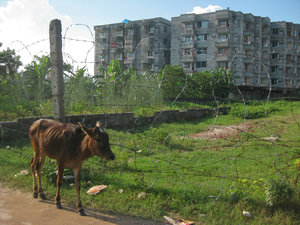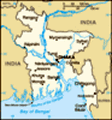Advertisement
Published: February 14th 2014

 Progress
Progress
In many cities I would say that filling fields with cement apartment blocks is not progress, but here I see too many people sleeping in the streets. Whatever the homes look like, at least they're homes.The streets of Dhaka change dramatically between 7am and 4pm. By 6 o’clock in the evening many streets are at a bumper to bumper standstill. Gone are the street sweepers and the construction workers brushing their teeth on the side of the road.
Although it can take less than ten minutes to drive to work in the morning, there have been days when it took over an hour to drive home. I can usually walk in half an hour or less. On more than one occasion I have actually left the car stuck in traffic (with the driver at the wheel) and walked home. Driving on the main roads in the evenings, it feels like our average speed is two inches per minute.
Most days it only takes about 20 minutes to get home, because we drive down a back road, through fields that are rapidly becoming high-rise apartment buildings. It’s an awkward transition. The goats still act like they rule the place, but trucks and an increasing number of cars choke the narrow road. It is mostly one way, leaving the area I work in and bursting out on the main road. That being said, I have yet

 Grazing by Work
Grazing by Work
I see this mini-herd of sheep every day as I leave work, wandering among the partly constructed apartment buildings. In a country as hot as Bangladesh I wonder how these sheep survive. They are the only ones I have seen anywhere in the country.to see a one way road in Dhaka that does not have cars and rickshaws going the wrong way on it.
This road was entirely dirt when I first arrived in Dhaka. It was full of bumps and holes. When it rained the whole place turned into an impassible bog. During the monsoon we had to take the main roads the whole way home, which usually takes an hour or so. Last summer they closed the road to pave part of it. That meant we had to take the main road home every day from work. By August they had finished paving and opened the road up again.
The part of the road closest to where I work is still unpaved. In the dry season dust fills the air and every passing car throws up clouds of choking fine silt. We ease carefully over the bumps, often scraping bottom going down into the holes. When the rains come back we might have to abandon our short cut again.
The most peculiar part of my commute in Dhaka is having a driver. I wouldn’t be able to share a car without one, since he takes my carmates’ children

 Recycling
Recycling
The road I take in the afternoons is home to several recycling collection centers. These are not official buildings, but areas where giant bags of empty plastic bottles are taken to be sorted by type of plastic. Just like the transportation of these giant bags, the sorting is done by hand. The sorted plastics are then sold to manufacturing companies.to school after we’ve gone to work. As I mentioned in my previous blog, rented cars come with drivers. I had no desire to buy a car when I arrived, mostly because the roads are so terrible. Then I learned that many foreign workers here share cars with colleagues. Car sharing has always sounded like a great idea to me, especially in places where public transportation options are limited.
There are city busses here, although they are not supported by the city government. Just last year the group Urban Launchpad released their map of the bus system here. The project was funded mostly through Kickstarter. Previously you had to find out about busses by word of mouth. If you are illiterate in Bangla (like me) then you can’t read the destination signs posted in bus windows. I have yet to try the bus, partly because I can’t read the signs and partly because they are famous for being battered and getting in accidents. Usually when I see one coming I just try to stay out of the way.
There are no busses going between where I live and work anyway. Bikes are a better option, if you’re brave

 Construction
Construction
Just like the transportation and sorting of recyclables, the transportation of construction materials is often done by hand.enough to ride through the traffic. Several of my colleagues bike to work and I admire their dedication. It’s not an easy place to ride a bike. For the last few months of my contract here I’ll continue to commute by car. In a city with such terrible traffic and air pollution I’m often embarrassed to be seen in a car, but at least I’m carpooling. We take rickshaws and carpool with other friends on weekends too.
Getting around Dhaka is like no other city I’ve ever seen. I thought the Istanbul transportation system was complicated, which it was, but at least it was dependable. Dhaka is an unpredictable adventure every morning I step out the door. It’s not complicated: I have a car and I know how to give directions to a rickshaw driver in Bangla. But Dhaka is changing fast, much faster than the roads can keep up with. It’s an exciting place and I am sure that a blog about transportation here five years from now will have a very different story to tell.
This blog is also available on www.heatherjasper.com
There are more photos below.
Advertisement
Tot: 0.09s; Tpl: 0.013s; cc: 10; qc: 29; dbt: 0.0594s; 1; m:domysql w:travelblog (10.17.0.13); sld: 1;
; mem: 1.1mb



 Progress
Progress
 Grazing by Work
Grazing by Work
 Recycling
Recycling
 Construction
Construction


































